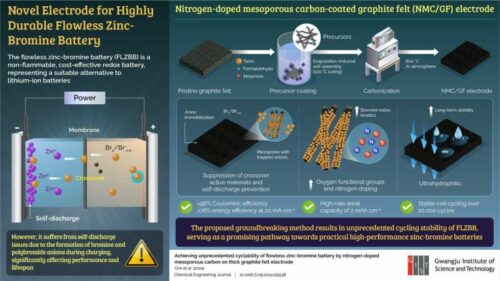Researchers at the Gwangju Institute of Science and Technology in Korea developed a novel nitrogen-doped mesoporous carbon-coated thick GF (NMC/GF) electrode.

The novel electrodes effectively suppress the crossover of bromine and bromine complexes, preventing self-discharge and enhancing flowless zinc-bromine batteries’ electrochemical performance and cycling stability. The researchers from the Gwangju Institute of Science and Technology are credited with this development.
As global energy shifts to sustainable sources like solar and wind power, energy storage systems (ESSs) are needed to manage volatile production and irregular supply. While lithium-ion batteries dominate the market, they pose fire risks. The flowless zinc-bromine battery (FLZBB) offers a safer, cost-effective alternative with non-flammable electrolytes.
FLZBBs use a positive electrode, negative electrode, electrolyte, and separator, holding the electrolyte in a gel-like container. Graphite felt (GF) electrodes are stable in acidic electrolytes, but bromine ions can cause self-discharge, affecting performance. Despite efforts to address this, self-discharge remains a significant issue for FLZBBs.
The researchers fabricated the NMC/GF electrodes using a simple, cost-effective evaporation-induced self-assembly method. A pristine GF felt was coated with precursor materials mixed in a solvent, followed by drying and curing. When applied to a flowless zinc-bromine battery (FLZBB), the new electrodes effectively suppressed the crossover of active materials and prevented self-discharge. This success was attributed to the mesopores present on the GF fibres in the NMC/GF electrodes.
The FLZBB with NMC/GF electrodes demonstrated impressive performance, achieving Coulombic and energy efficiencies of 96% and 76%, respectively, at a current density of 20 mA cm⁻², along with a high-rate areal capacity of 2 mAh cm⁻². The battery exhibited remarkable durability, maintaining charge/discharge cycling stability for over 10,000 cycles. The use of the thick GF electrode also has the potential to reduce the overall cost of the battery.
This technology can facilitate using FLZBBs, resulting in safer energy storage systems (ESSs) and more stable renewable energy infrastructures.
Reference: Youngin Cho et al, Achieving unprecedented cyclability of flowless zinc-bromine battery by nitrogen-doped mesoporous carbon on thick graphite felt electrode, Chemical Engineering Journal (2024). DOI: 10.1016/j.cej.2024.151538








